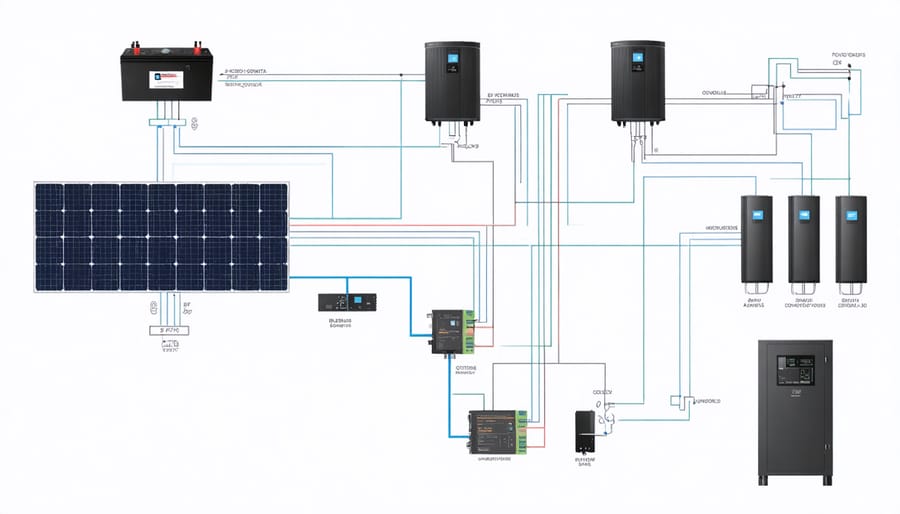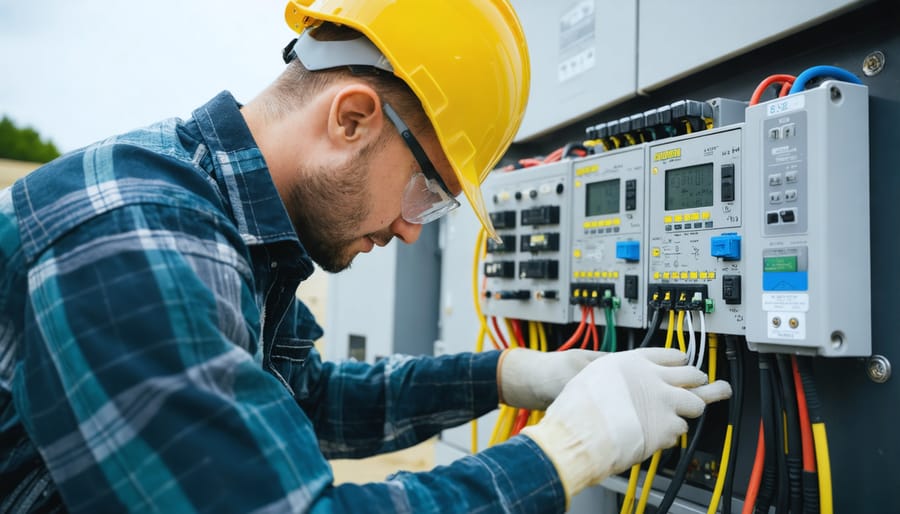Power Your Remote Dream: Off-Grid Battery Systems That Actually Work

Transform your energy independence dreams into reality with modern battery backup systems that power homes and businesses completely off the grid. These sophisticated power storage solutions have revolutionized how we think about energy autonomy, combining advanced lithium-ion technology with smart energy management systems to deliver reliable, sustainable power 24/7.
Today’s off-grid battery systems represent the pinnacle of renewable energy innovation, capable of storing surplus solar power during peak production hours and providing consistent electricity through nights and cloudy days. Whether you’re powering a remote cabin in the Alps or ensuring business continuity during grid outages, these systems offer unparalleled flexibility and control over your energy consumption.
As Europe accelerates its transition to renewable energy, off-grid battery solutions have emerged as a critical component in achieving energy independence. With proper sizing, modern systems can support everything from basic household needs to energy-intensive industrial applications, all while maintaining a minimal environmental footprint and reducing long-term operational costs.

The Core Components of Modern Off-Grid Battery Systems
Battery Technology Selection
Selecting the right battery technology is crucial for creating a reliable off-grid power system. Currently, four main battery types dominate the European market, each with distinct advantages for specific applications.
Lithium-ion batteries represent the most popular choice, offering excellent energy density, long cycle life, and minimal maintenance requirements. Their compact size and high efficiency make them particularly suitable for residential installations, though their higher initial cost is balanced by superior long-term performance and durability.
AGM (Absorbent Glass Mat) batteries provide a reliable and cost-effective solution, especially for smaller systems. These maintenance-free batteries handle temperature variations well, making them suitable for various European climate conditions. However, they typically offer shorter lifespans compared to lithium-ion alternatives.
Lead-acid batteries remain relevant for budget-conscious projects, offering proven reliability and wide availability. While they require regular maintenance and have lower energy density, their lower initial cost and simple charging requirements make them suitable for basic backup systems.
Salt-water batteries are emerging as an eco-friendly alternative, using non-toxic materials and offering excellent safety characteristics. Though currently less common in European installations, their sustainable composition and long service life make them increasingly attractive for environmentally conscious projects.
The choice ultimately depends on factors including budget, space constraints, maintenance capability, and expected system demands. Professional assessment of these factors ensures optimal battery selection for specific off-grid requirements.
Power Management Systems
At the heart of any off-grid battery system lies sophisticated power management systems that ensure optimal energy flow and system protection. These systems comprise three essential components: charge controllers, inverters, and monitoring equipment.
Charge controllers act as guardians of your battery bank, regulating the incoming power from solar panels or other renewable sources. They prevent overcharging and extend battery life by maintaining optimal charging parameters. Modern MPPT (Maximum Power Point Tracking) controllers can increase charging efficiency by up to 30% compared to traditional models.
Inverters transform stored DC power into AC power suitable for household appliances. Pure sine wave inverters, increasingly common in European installations, deliver clean power that matches grid quality, ensuring sensitive electronics operate safely. Hybrid inverters offer additional flexibility by managing multiple power sources and providing seamless switching between stored and generated power.
Monitoring equipment provides real-time insights into system performance through user-friendly interfaces. Advanced systems offer remote monitoring capabilities via smartphone apps, allowing users to track energy production, consumption, and battery status. These smart monitoring solutions can predict maintenance needs and optimize energy usage patterns, contributing to system longevity and efficiency.
Integration of these components creates a robust framework for reliable off-grid power generation, ensuring consistent energy supply while maximizing system performance and battery life.
Smart Design Principles for Remote Locations
Capacity Planning and Load Analysis
Accurate capacity planning and load analysis are crucial steps in designing a reliable off-grid battery system. Begin by conducting a detailed energy audit of your property, listing all electrical appliances and their power consumption in watts. Calculate both your daily and peak energy requirements, considering seasonal variations and future expansion needs.
For European households, average daily consumption typically ranges between 8-15 kWh, but this varies significantly based on lifestyle and climate. To determine your system’s capacity, multiply your daily energy requirement by the number of autonomous days desired – typically 2-3 days for most installations, though Nordic regions might require more during winter months.
Factor in system inefficiencies by adding a 20% buffer to your calculations. Consider depth of discharge (DoD) limitations; while modern lithium batteries can safely discharge up to 80%, maintaining a shallower DoD of 50-60% extends battery life significantly. Temperature impacts battery performance, with capacity typically reducing by 1% for every degree Celsius below 20°C.
Essential calculations include:
– Peak load requirements (simultaneous power draw)
– Average daily consumption
– Seasonal variations in energy usage
– Battery capacity requirements
– Inverter sizing for peak loads
Use monitoring tools and smart meters to track actual usage patterns for several months if possible. This data-driven approach ensures more accurate sizing and prevents both under-and over-specification of your system. Remember to account for efficiency losses in inverters (typically 5-10%) and include growth margin for future needs, typically 20-30% additional capacity.
Weather Resistance and Environmental Protection
Off-grid battery systems must withstand diverse environmental conditions, from freezing Nordic winters to scorching Mediterranean summers. Proper weather resistance and environmental protection are crucial for ensuring system longevity and reliable performance throughout the year.
The battery enclosure serves as the first line of defence against environmental threats. Modern systems typically feature IP65 or IP66-rated enclosures, protecting against dust ingress and water jets from any direction. For regions with extreme temperature variations, thermal management systems maintain optimal operating conditions, typically between 15°C and 25°C, through integrated heating and cooling mechanisms.
Humidity control is another critical aspect, particularly in coastal areas where salt-laden air can accelerate corrosion. Advanced enclosures incorporate dehumidification systems and corrosion-resistant materials like marine-grade aluminium or stainless steel. Some manufacturers also apply special protective coatings to enhance weather resistance further.
For underground installations, additional measures protect against soil moisture and flooding. This includes elevated mounting platforms, waterproof cable entries, and proper drainage systems. In areas prone to severe weather events, reinforced mounting brackets and impact-resistant covers provide extra protection against strong winds and flying debris.
Temperature monitoring systems play a vital role in environmental protection, automatically adjusting charging parameters based on ambient conditions. This prevents battery degradation and ensures optimal performance across seasons. For regions experiencing extreme cold, insulation systems and heating elements maintain battery temperature above freezing, preventing capacity loss and potential damage.
Regular inspection of weather seals, ventilation systems, and protective components ensures continued environmental protection throughout the system’s lifetime. This proactive approach to maintenance significantly extends the operational life of off-grid battery systems in challenging environments.
Integration with Renewable Energy Sources
Solar-Battery Synchronization
Effective synchronization between solar panels and battery systems is crucial for maintaining reliable power supply in off-grid installations. The process begins with proper sizing calculations, ensuring your solar array can adequately charge your batteries while meeting daily energy demands. Modern charge controllers play a vital role in this relationship, managing the power flow from panels to batteries and preventing overcharging or deep discharge scenarios.
For optimal synchronization, the system should incorporate smart monitoring technology that tracks both solar generation and battery status in real-time. This allows for automated adjustments based on weather conditions, energy consumption patterns, and battery state of charge. European installations particularly benefit from seasonal optimization features, which account for varying daylight hours throughout the year.
The battery inverter must be carefully matched to both the solar array capacity and battery specifications. This ensures efficient power conversion and maintains system stability. Many contemporary systems employ artificial intelligence algorithms to predict energy needs and adjust charging cycles accordingly, maximizing battery lifespan and system efficiency.
Load management systems further enhance synchronization by prioritizing essential appliances during low-generation periods. This intelligent power distribution helps maintain battery health while ensuring critical systems remain operational. Regular system audits and performance monitoring help identify potential synchronization issues before they impact system reliability.

Hybrid System Benefits
Hybrid renewable energy systems offer compelling advantages for off-grid installations by combining multiple power sources to create a more reliable and efficient energy solution. By integrating solar panels with wind turbines, micro-hydro systems, or backup generators, these systems significantly enhance power availability and system resilience.
The primary benefit lies in complementary energy generation patterns. While solar panels produce power during daylight hours, wind turbines can generate electricity during nighttime and cloudy conditions. This natural synergy ensures more consistent power supply throughout the year, particularly valuable in European regions with varying seasonal conditions.
Hybrid systems also optimize battery usage and extend storage life. When multiple energy sources work together, the batteries experience more balanced charging cycles and reduced strain, potentially doubling their operational lifespan. This translates to lower long-term maintenance costs and improved system reliability.
Furthermore, hybrid configurations allow for smaller battery banks compared to single-source systems, as the diverse energy inputs help maintain consistent charge levels. This reduction in battery capacity requirements can lead to substantial cost savings while maintaining system effectiveness.
The flexibility of hybrid systems also enables strategic energy management, allowing users to prioritize different power sources based on availability, cost-effectiveness, and environmental conditions. This adaptability ensures optimal system performance while maximizing renewable energy utilization.
Maintenance and Long-Term Performance
Regular maintenance and monitoring are crucial for maximising the lifespan and efficiency of your off-grid battery system. While these systems are designed for durability, understanding the long-term maintenance costs and implementing proper care routines will ensure optimal performance throughout their operational life.
Key maintenance practices include regular inspection of battery terminals for corrosion, checking connection tightness, and maintaining proper ventilation in the battery storage area. For lithium-ion systems, monitoring the battery management system (BMS) readings is essential, while lead-acid batteries require periodic water level checks and specific gravity measurements.
Implement a systematic monitoring schedule that includes:
– Monthly visual inspections of all components
– Quarterly testing of backup systems and safety features
– Bi-annual professional system assessment
– Regular software updates for smart monitoring systems
Temperature control plays a vital role in battery longevity. Maintain ambient temperatures between 20-25°C for optimal performance. Install temperature monitoring devices and ensure proper insulation of the battery storage area, particularly important in European climates with significant seasonal variations.
Data logging and performance tracking help identify potential issues before they become critical. Modern battery systems often include built-in monitoring capabilities that track:
– State of charge (SOC) and depth of discharge (DOD)
– Charging and discharging cycles
– System efficiency and power output
– Temperature variations and unusual patterns
Consider establishing a maintenance contract with a qualified service provider who can perform detailed annual inspections and necessary adjustments. This professional oversight, combined with regular self-maintenance, ensures your system operates at peak efficiency while maximising its service life.
Document all maintenance activities, including dates, observations, and any corrective actions taken. This record-keeping helps track system performance trends and supports warranty claims if needed.

Off-grid battery systems represent a pivotal advancement in sustainable energy independence, offering reliable power solutions for homes and businesses across Europe. As we’ve explored, these systems combine sophisticated energy storage technology with renewable power generation to create self-sufficient electrical installations that operate independently from the traditional grid.
The key to success lies in proper system sizing, component selection, and regular maintenance. Modern lithium-ion batteries, advanced charge controllers, and intelligent energy management systems have made off-grid living more accessible and reliable than ever before. The integration of smart monitoring solutions ensures optimal performance while minimizing operational costs and extending system lifespan.
Looking ahead, the future of off-grid battery systems appears increasingly promising. Technological innovations continue to drive down costs while improving efficiency and storage capacity. The European Union’s commitment to renewable energy and carbon neutrality by 2050 will likely accelerate the adoption of off-grid solutions, particularly in remote and rural areas.
As battery technology evolves and energy management systems become more sophisticated, we can expect to see even more efficient and cost-effective off-grid solutions emerge. The growing focus on sustainability and energy independence suggests that off-grid battery systems will play an increasingly vital role in Europe’s energy landscape, providing reliable power while contributing to a greener future.
Leave a Reply